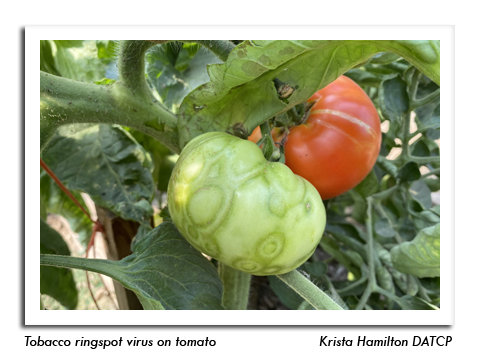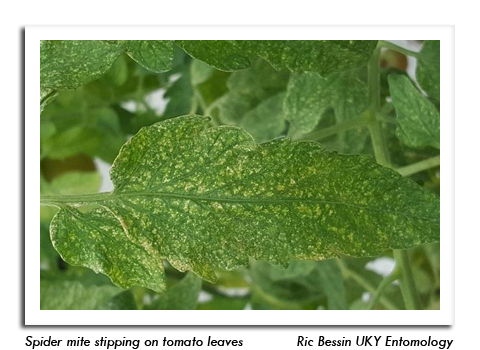
 |
|
|
Vegetables
Volume 65 Number 16 Date 08/20/2020 TOBACCO RINGSPOT VIRUS - The nepovirus Tobacco Ringspot Virus (TRSV) was diagnosed by the DATCP Plant Industry Lab earlier this month on tomato from a La Crosse County hoophouse. The symptoms observed included oval-shaped blisters on the fruits of at least three heirloom varieties. The blistering symptoms were similar to those caused by tomato brown rugose fruit virus (ToBRFV), a newly identified virus of tomato and pepper that was detected and eradicated from Arizona and California greenhouses in 2018 and 2019. TRSV occurs in a wide range of plant hosts (cucumbers, soybeans, tobacco, many weeds) and is transmitted mechanically (contaminated tools, hands, plant-to-plant), by seed transmission, and by nematodes. Seed transmission has been reported as the main form of TRSV transmission in cucumber and soybeans. Unlike the emerging ToBRFV, TRSV reportedly causes only minor damage and does not spread rapidly. As with other plant viruses, good sanitation is imperative for preventing transmission. Seed and transplant production are the most critical entry points for contaminating hundreds, or potentially thousands, of plants. Using only certified seed, washing and sterilizing hands and tools often, wearing single-use gloves that are discarded between greenhouses, and disposing of symptomatic plants are all key control measures. Plants, trays and media should be disposed of through incineration--DO NOT spread it out on your fields. Tomato growers should be alert for virus symptoms as harvest continues and send suspected plant material to the UW-Plant Disease Diagnostic Clinic for testing: https://pddc.wisc.edu/sample-collection-and-submission/ TWO-SPOTTED SPIDER MITE - Localized outbreaks in vegetables and other crops have been favored by this month's predominantly dry weather pattern. Inspections found mite damage on beans and tomatoes and at a La Crosse County community garden, and problems are expected to increase through the end of August as where dry conditions persist. Two-spotted spider mites can damage tomatoes, beans, muskmelons, watermelons, and sweet corn, causing plants to turn yellow, drop leaves, and potentially die when infestations are severe. Fruits from severely infested plants are often small, poor-quality and unmarketable. Vegetable growers are encouraged to watch for developing mite problems such as leaf stippling and fine webbing that may cover the entire plant. Infestation can be confirmed by shaking symptomatic leaves onto a sheet of white paper or by observing infected leaf areas with a hand lens. At this late point in the season, watering or irrigation is perhaps the best option for short term control of mite infestations. LATE BLIGHT - UW Vegetable Pathologist Dr. Amanda Gevens reported the state's first late blight case of the season on August 10. The disease was confirmed in in an Adams County potato field. Although dry weather has limited disease development in the last 10 days, late blight can progress rapidly under favorable cool, wet weather conditions, and entire plants may decline and die in as few as 7-10 days. Gardeners in central Wisconsin are advised to increase scouting through September for disease symptoms, including leaf, stem, and fruit lesions that have a water-soaked appearance. Removal and destruction of infected plants is required if lesions are noticed. Composting will not kill the pathogen and is not recommended. -- Krista Hamilton, DATCP Entomologist 


.jpg)
.jpg)
|
|
|